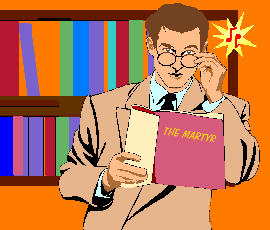| |
One day in 1983, Myron Fink, composer and teacher, thinking
his 14-person office too cramped and too noisy for inspiration,
thought he'd spend a few hours in the library. As he wandered
somewhat aimlessly about the stacks, a purple book caught
his eye... |
 Like
most creative people, composers don't sit around staring
at a blank wall, worrying about where the next musical idea
is going to come from. And like most bright ideas, musical
ones just happen. Like
most creative people, composers don't sit around staring
at a blank wall, worrying about where the next musical idea
is going to come from. And like most bright ideas, musical
ones just happen.
Here's how the music and the poetry of The Conquistador
came to be. During a visit to the library while he was still
a professor at Hunter College in New York City, Myron Fink
chanced upon a book. It may have been the purple cover that
first caught his eye, but it was the title that grabbed
him: The Martyr, The story of a Secret Jew and the Mexican
Inquisition in the Sixteenth Century by Martin Cohen.
He checked it out and on the train commute back to his Connecticut
home read page after page after page.
|
Instantly
he knew - this was going to be the subject of his next opera!
A subject unknown to him and to most Americans, it was fascinating
from a historical point of view - who had ever heard of
Jews escaping from Mexico into the American southwest; indeed,
who had ever heard of 16th century Jewish conquistadors
- merchants, scholars, yes, but conquistadors!? And it made
a fascinating study in psychology - of a man in denial,
torn between his blood heritage and his religious faith;
and of a society bedeviled by human intolerance - a demon
that has not been stilled by time and a theme that is as
modern now as it was then.
Convinced he had the elements of an exciting music drama,
Myron Fink who does not write his own libretto, called his
friend - librettist Donald Moreland.. ..
|

"What?!!! Another opera?!!
 Nah,
it'll just be another Don Carlo... Nah,
it'll just be another Don Carlo...
 And will it ever get produced?"
And will it ever get produced?"
|
The librettist's first impulse was to hang up the phone!
But Myron was persistent and gave his friend the book to
read. He did, and after a series of give-and-take with Myron,
Don Moreland was, in his own words, "hooked".
He signed on to the project. It would take him nine years
to complete the text. After all, crafting a libretto (about
the distant past) that works (for modern audiences) is no
easy task, especially when one has to distil historical
events that take place over decades into 3 hours of musical
drama. The Conquistador was going to be an OPERA, not merely
a pageant! (Click HERE to read
Don Moreland's own vivid account of his role in the genesis
of the opera.)
|
With libretto in hand, Myron set about his task of completing
the music - he already had a potpourri of musical ideas
in his head. He played the first bars of the music in his
mind, and everything soon flowed from there. In nine months
he had a piano score. And when finally the work was commissioned
for a world-premiere performance, he produced the orchestration
within a year. To Myron, composing music is not unlike writing
a literary piece. Only instead of forming phrases from words,
and sentences from phrases, the composer starts off by thinking
in tones, which he then assembles into musical phrases which
then develop into themes. With the orchestration, the work
becomes magically multi-dimensional; in the case of opera,
as Don Moreland puts it, the libretto, "the skeleton
of the text", is given "flesh and blood".
But only with the mounting of a stage production does the
opera reach its full incarnation - as The Conquistador
did in San Diego in the year 1997.
|
|
![]()
